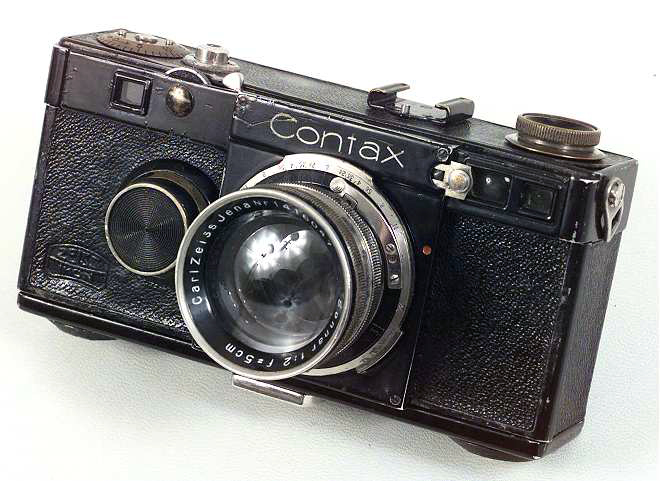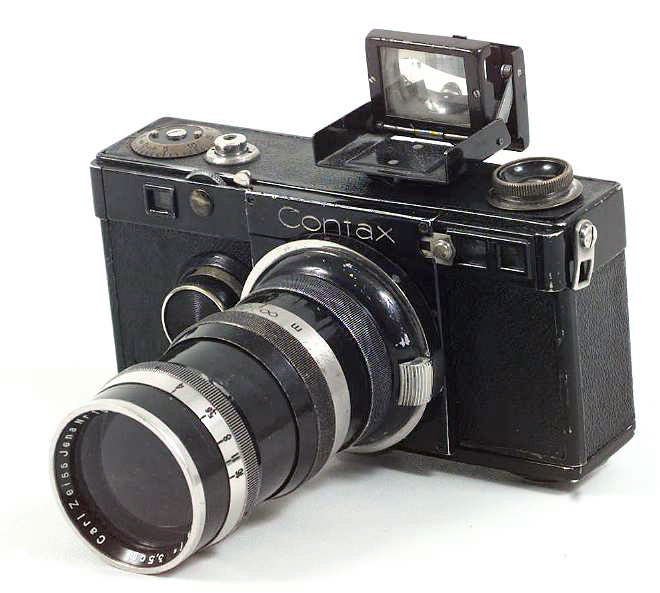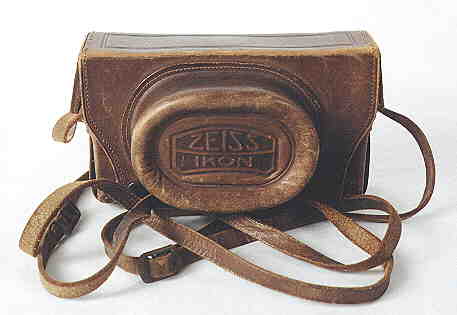
Photographica Pages
An online guide to collectable cameras and related stuff
Zeis Ikon Contax I

An early Contax I with 50/2 Sonnar. Note the dimple over the end of the focusing wheel's shaft.
The engineers at Zeiss must have realized they needed to come up with
something special. Leitz had their Leica cameras on the market longer than Zeiss
Ikon had been an entity. The Leica had won the respect of professional
photographers with the quality, practicality and ease of use. The Leica already
had (and still has) a very loyal and devoted following. What they were required
to design and build was not something merely as good as the Leica. They had to
build something better, significantly better, giving compelling reason to choose
the Contax over the Leica.

An early Contax I with 50/2 Sonnar. Note the dimple over the end of the focusing wheel's shaft.
So they did.
In 1932 the Contax came out on the market. This was the same year Leitz released the Leica D, their first model with built in coupled rangefinder. The length of the rangefinder base is a big factor in it's accuracy, and the Contax rangefinder was considerably longer than the Leica's. The top speed on the Contax was 1/1000 of a second as opposed to the Leica's 1/500. The Contax was designed to be faster handling, with a removable back to facilitate rapid film loading, which could be done cassette-to-cassette to eliminate rewinding. The Leica had a baseplate film loading system that was cumbersome and could lead to a failure to advance if you were careless. The Contax lenses mounted with a quick bayonet, rather than a thread mount that required several turns, as found on the Leica. And the Contax had a built in finder mask, usually for the 135mm lens, but it could be had with the 85mm mask instead.
And the lenses. By the end of 1932, Zeiss offered the 40/2 Biotar, 50/1.5 Sonnar, 50/2 Sonnar, 50/2.8 Tessar, 50/3.5 Tessar, 85/4 Triotar, and 135/4 Sonnar. In contrast, Leitz offered the 35/3.5 Elmar, 50/3.5 Elmar, 50/2.5 Hektor, 73/1.9 Hektor, 90/4 Elmar, 105/6.3 Mountain Elmar, and 135/4.5 Elmar. The most important advantage went to Zeiss with the 50/1.5 and 50/2 lenses. The following year Zeiss raised the bar with the introduction of the 28/8 Tessar, 85/2 Sonnar, 180/6.3 Tele-Tessar-K, while Leitz only released their 50/2 Summar. Both makes extended their shutter speed ranges with slow speeds, Zeiss to 1/2 second, Leitz to a full second.
Leitz used a new model designation every time they changed the design, offering different models with different features (and prices) concurrently. Zeiss had only one model, the Contax, until they released the Contax II and III in 1936. But they constantly made running changes to the design of their Contax, leaving us with no clear cut factory designations of the different versions. There are least two different sets of variations that have been drawn up to describe the Contax I. Hans-Jurgen Kuc uses seven numbered variations in his beautiful book "Auf Den Spuren Der Contax", and Jim McKeown uses six letter variations in his price guide. For less than perfect reasons I use McKeown's system; it's what I've used in the past in my catalog listings, and Kuc's book is in German, and I don't read German well. Both systems can be confusing.
Contax Ia- No slow speeds, no foot around tripod socket to keep the camera sitting level with a heavy lens mounted. The serial number starts with either "AU" or "AV". The viewfinder window is between the rangefinder windows. The camera may have raised dimples over the ends of internal shafts on the focusing wheel and the infinity lock release. Some cameras have one, some both and some none. The sheetmetal plate surrounding the lens mount is separate from the front plates surrounding the rangefinder and viewfinder windows. The distance scale around the lens mount is painted black with white numbers.
Contax Ib- The front plates are combined into one, surrounding the finder windows and the lens mount. The camera does not have dimples any more. Otherwise the same as the previous model.
Contax Ic- Slow speeds have been added, as has a foot on the tripod socket. The front plate now also extends around the shutter speed dial on the front.
Contax Id- A button has been added to release the infinity lock on the focus, at 1 o'clock to the lens. The distance scale is now bright nickel with black numbers
Contax Ie- The viewfinder has been moved from between the rangefinders to the outside, causing the rangefinder on the wind side to be moved out towards the end of the camera. There is now a groove on the front plate running between the word "Contax" and the rangefinder window, directly under the infinity lock release.
Contax If- The marker for the shutter speed dial is now an arrow, replacing the slotted screw head from previous models. The accessory shoe now has four screw heads visible in it.
I believe it is possible to find variations with features split between two versions. Among the changes to this model during the four years of production not listed above include the amount of rounding on the edges of the camera, size of the infinity release lock, the shape and construction of the accessory shoe, the shape of the tripod socket casting, whether the finder mask has a notch in the nameplate, the shape of the shutter release, the shape of the film counter pointer, the location of the arrow for the counter release, the shape of the eyepiece surrounds on the cameras back, the shape of the well on the inside of the camera for the tripod socket and the location of the serial number.

The Contax I with a 135 Sonnar and folding 50 and 135mm Albanda finder.

The case for the Contax I.

Some models are marked for export to China. These are rare. They are known with Chinese characters engraved, which say "Made in Germany".
